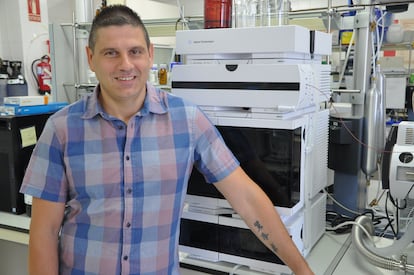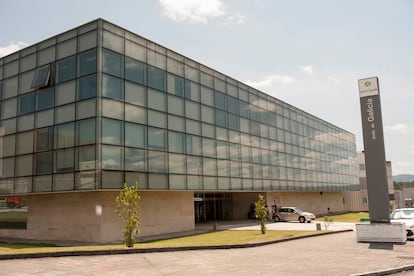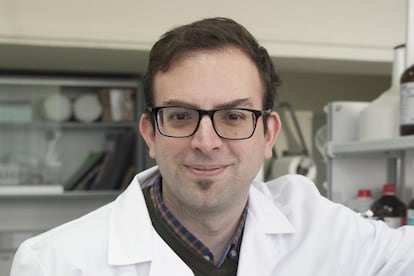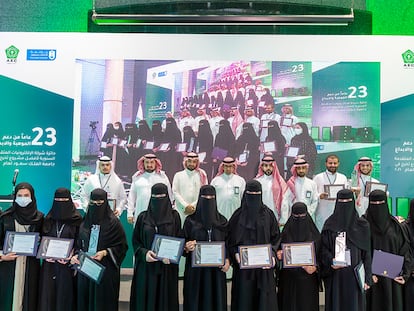A researcher who publishes a study every two days reveals the darker side of science
Spain’s most prolific scientific academic — meat expert José Manuel Lorenzo — put his name on 176 papers last year, exposing an underworld of shady practices

Meat expert José Manuel Lorenzo, 46, is the researcher who has published the most scientific studies in Spain. He put his name on 176 papers last year, according to a count by John Ioannidis — an expert in biomedical statistics at Stanford University — which was requested by EL PAÍS.
Lorenzo publishes a study every other day (if you include weekends). It’s an astonishing figure, far above the second-highest ranked scientist: the prestigious ecologist Josep Peñuelas, 65, who published 112 studies in 2022.
The vast majority of Lorenzo’s colleagues in his field typically publish a dozen articles a year at most. The University of Vigo, in Galicia — where Lorenzo is an associate professor — claims that he is “the biggest meat expert in the world.” However, a French researcher — who usually headlines international conferences on the subject of meat — tells EL PAÍS that they have never heard the Spaniard’s name. Lorenzo’s case reveals the darker side of science.
Researchers are under brutal pressure to publish studies. Their salary increases, promotions, project funding and social prestige depend on evaluations in which their performance is measured practically by weight. This system — known as “publish or perish” — has created monsters. Thousands of scientists around the world publish at least one study every five days, according to Ioannidis’s calculations. They are the so-called “hyperprolific” researchers, who have an amazing production rate, which is sometimes suspicious.
José Manuel Lorenzo is the head of research at the Meat Technology Center (CTC) — an entity dedicated to meat products, supported by the regional government of Galicia — in San Cibrao das Viñas, a city in the Spanish province of Ourense. A person who has worked with him recalls that, around 2018, his laboratory became “a sausage factory.” Lorenzo went from publishing less than 20 studies a year to signing his name to more than 120. “He doesn’t even have time to read them,” says another person, who has collaborated on projects with the man.
At one point, Lorenzo began collaborating with exotic researchers — who nobody knew about — on topics that have nothing to do with meat. Four months ago, he published a study on the hospital management of monkeypox, alongside Iraqi, Indian and Pakistani co-authors. And a year ago, he and some researchers from India and Saudi Arabia published an article on the treatment of gum disease with bee venom. In a telephone conversation with EL PAÍS, Lorenzo admits that he doesn’t know any of these co-authors in person, nor is he an expert on any of these issues.

India is one of the countries where so-called “paper mills” are concentrated — factories that churn out scientific studies which are already written and ready to be published in specialized journals. Co-authorship is offered in exchange for money. EL PAÍS requested price rates from one of the Indian companies that sends their offers to Spanish scientists: iTrilon, based in Chennai. The company’s scientific director Sarath Ranganathan offered the possibility of being the first author of a study that was already written — entitled Next-generation neurotherapies against Alzheimer’s — in exchange for about $500. It’s also possible to be the fifth co-author of an article titled Emergence of rare microbial infections in India for $430. iTrilon promises to publish these ready-made studies in the journals of the world’s leading scientific publishers: Elsevier, Taylor & Francis, Springer Nature, Science and Wiley. Last year, the academic publishing industry acknowledged that at least 2% of studies each journal receives are considered to be suspicious. Sometimes, the number of suspicious studies is marked as high as 46%.
Lorenzo categorically denies having resorted to these services, but he is aware of the existence of a market for the sale of authorship. “I received several emails from a person who offered to pay me €1,000 or €2,000 [$1,070-$2,144] to put him as a co-author, but I didn’t even answer,” he affirms. Lorenzo says that scientists from India, Pakistan, Iraq and other countries often invite him to collaborate, even if they don’t know him. According to him, plant biochemist Manoj Kumar — from the Central Institute for Research on Cotton Technology, in Bombay — asked him to participate in a study on the treatment of gum diseases and he — an expert in meat — accepted. Lorenzo says that he limited himself to reviewing the English, proposing some graphics and signing it as co-author.
“I get a lot of emails every day and, if I have time and I [am interested in] the topic they raise, I say yes,” he explains. “I trust people. If they’re cheating me, I don’t know. It’s unethical to use a person’s name to publish a study or charge for co-authorship. I’m against all these practices. And, as far as I know, they’ve never used me for that,” he maintains.
Scientific journals have a perverse incentive to publish studies of dubious quality. In the past, it was readers who paid to read the articles, which were inaccessible without a subscription. But in recent years, another model has been imposed, in which the authors themselves are the ones who pay up to $6,500 to private publishers so that their studies can be published with open access to any reader. The change in this model has caused an earthquake in the world of science. In 2015, there were barely a dozen biomedical journals that each published more than 2,000 studies per year, representing 6% of total production between them. There are now 55 of these so-called “mega-journals” — together, they publish almost a quarter of all specialized literature, according to recent research by John Ioannidis.
Half of the top mega-journals come from the same publisher: MDPI, a corporate giant founded in Basel, Switzerland, by Chinese chemist Shu-Kun Lin. It currently controls 427 journals. Its top publication — International Journal of Environmental Research and Public Health — publishes nearly 17,000 studies each year, a number that makes it difficult to ensure quality. This journal charges authors more than $2,500 for the publication costs of each work. Five years ago, more than a dozen publishers of Nutrients — another one of these mega-journals — resigned, alleging that MDPI pressured them to accept low-quality studies and increase revenue. The work by meat expert José Manuel Lorenzo on gum disease was published in the journal Antioxidants — also owned by MDPI.
Shu-Kun Lin’s publishing house has become an empire in a short time. MDPI journals offer an easy way to publish studies, thanks to their less-demanding requirements. A scientist can submit a paper to them and see it published in as little as a month after a cursory review, instead of the typical six months that other publishers require. Emilio Delgado — professor of Research Methodology at the University of Granada in Spain — makes a devastating diagnosis about this situation: “The MDPI journals have engulfed the system.”
Delgado jokes that, in the academic world, there is already talk of “MDPI professors,” which refers to those who have risen thanks to CVs based on this type of shoddy work. He notes that Spanish universities have become veritable “factory farms” for insubstantial studies. Delgado and his colleague Alberto Martín have analyzed this change in the behavior of Spanish scientists. Their data shows that, in 2015, barely 0.9% of Spanish production was published in MDPI journals, compared to a 0.6% rate worldwide. Six years later, the percentage in Spain shot up to nearly 15% — double the proportion in the rest of the world. Some universities focus on getting their studies published in MDPI journals, such as the Catholic University of Ávila (71%), Alfonso X el Sabio University (42%), the University of Extremadura (30%) and the Catholic University of Murcia (27%). At the most prestigious university in Spain — the Complutense University of Madrid — the percentage exceeds 12%.

The third-most prolific scientist in Spain is Jesús Simal. A professor of Nutrition at the University of Vigo, he had 110 studies published last year… nearly one every three days. Simal is a specialist in chemical contaminants in food, but his resume also includes studies on different topics with exotic co-authors. A year ago, he published a study on the CRISPR gene-editing tool against cancer, alongside co-authors from Bangladesh, Indonesia and Saudi Arabia. The professor (and former vice-chancellor of his university) admits that he doesn’t know the rest of the signatories in person and attributes his unusual production to his cooperation with “multiple international research teams.” Simal has also occasionally collaborated with José Manuel Lorenzo. Together, they have written a book on fish food.
Fourth place on the list of the most prolific scientists in Spain is occupied by the Japanese psychiatrist Ai Koyanagi, with a peak of 108 annual studies (not counting minor works). Koyanagi was the co-director of the Epidemiology of Mental Disorders working group at the Sant Joan de Déu Research Institute, in the Barcelona metropolitan area. This past April 30, she resigned from her post, after EL PAÍS revealed that the psychiatrist is one of the 19 scientists in Spain who have falsely declared — in exchange for money — that their main place of work is a Saudi university. This is meant to help the Arab institution cheat its way up international academic rankings. A spokesman for ICREA — the Catalan public institution that paid Koyanagi’s salary — said that she will be looking for work outside of Spain.
To evaluate the performance of a researcher and decide on promotions or salary increases, institutions consult their production in international databases, such as the Web of Science, from the multinational company Clarivate. Chemist Nandita Quaderi — the vice president of the Web of Science platform — announced this past March 20 that her team had detected more than 500 suspect journals, thanks to a new artificial intelligence program created to clean up “increasingly contaminated academic records.” The company has already removed more than 80 journals from its database, including 15 mega-journals and MDPI’s aforementioned International Journal of Environmental Research and Public Health. It’s the journal in which Spanish scientists have published the most in the last five years, with more than 5,400 studies, according to an analysis by Rafael Repiso and Ángel María Delgado Vázquez, two professors of Information Science.
“We’re losing millions of euros of public money paying for the publication of studies that usually don’t contribute anything — like parrots, they only repeat what everyone already knew about,” laments Delgado Vázquez, from the Pablo de Olavide University, in Seville. Their analysis reveals that the 82 journals now expelled from the database have published almost 190,000 studies in the last five years. Some 7,000 — almost 4% — have Spanish co-authors. Spanish institutions have spent more than €12 million — almost $13 million — to pay the publication costs of these controversial studies, according to their calculations.
“It’s not necessary to generalize, but in our universities, we all know of a professor whose curriculum has grown mysteriously — in a very short period of time — and who is managing to be promoted in an unusually short period of time. The rot is there. whoever doesn’t smell it is covering their nose,” says Delgado Vázquez. Five Spanish public universities — the universities of Granada, Valencia, Extremadura, Seville and Almería — published almost 1,900 studies in the controversial International Journal of Environmental Research and Public Health in just five years. “In addition to the wasted public money is the inequality that this causes in the scientific system. These shameless professors make progress in their careers, while honorable people are left on the sidelines. This is what is truly unfortunate,” Delgado Vázquez emphasizes.

A scientist’s performance is also measured by the number of times his or her work is cited by other researchers. Publishing a huge number of studies and belonging to an international network of colleagues (who do the same thing and cite each other) is an easy way to climb some international rankings. The Technology Center for Meat boasts that “four of the top five experts in meat products” in the world are researchers within the organization, according to data from the U.S. portal Expertscape, which values studies by weight. In this list, José Manuel Lorenzo is the first in the world, followed by his laboratory colleagues Paulo Munekata, Mirian Pateiro and Rubén Domínguez. These last two are also implicated in the Saudi plot to cheat in the global rankings.
The fifth-most prolific scientist in Spain is Toni Frontera, a professor of Chemistry at the University of the Balearic Islands. He co-authors a hundred studies each year. “I work eight hours and then eight more, because my hobby is publishing. I love it. I work basically every day of the year: Saturdays, Sundays, at Christmas,” he assures EL PAÍS in a telephone conversation. He has just published a study on the structure of a molecular complex with pharmacological potential, together with researchers from Saudi Arabia, Pakistan, New Zealand and Egypt. Frontera admits that he doesn’t know any of his co-authors and says that he limited himself to making computer simulations based on experimental data that was sent to him. “They contacted me via email. If there’s been a sale of authorship, or if they’ve added authors [who in reality haven’t done anything], I can’t really know,” the professor states.
The sixth-most prolific researcher is Rafael Luque, a chemist expelled from the University of Córdoba six months ago for his involvement in the Saudi plot. Luque — who, for the next 13 years, is suspended from the university and forbidden from collecting a salary — put his name on 98 studies last year, including a work put out by the Springer Nature publishing house about the photodegradation of ibuprofen in wastewater. He co-authored it with seven Iranians. The British engineer Nick Wise, from the University of Cambridge, has denounced that the co-authorships of said study went on sale a few months before. Luque affirms that he has never paid to sign someone else’s study, but adds that he doesn’t rule out the possibility that one of his Iranian co-authors paid to appear.

The MDPI publishing house has created a new business model. Its periodicals invite scientists — even the most mediocre ones — to be editors of a multitude of special issues, turning researchers into their commercial agents (who aren’t paid). A guest editor will subsequently offer their colleagues to publish studies in said journal, as long as they pay the $2,500 or so in publication expenses. In return for this networking, the guest editor will be able to publish one or more free articles in the special issue. These are similar to pyramid schemes, according to Isidro Aguillo, from the Spanish National Research Council (CSIC). Each MDPI journal publishes hundreds of special issues a year, multiplying the number of regular issues. MDPI increases its profits, while thousands of guest editors pad their CVS.
Delgado Vázquez and Repiso urge institutions to consider these practices to be demerits, instead of merits, as is currently the case. “A demerit [should be applied] when you’re trying to sell the idea that your article has been published in an international journal, when the reality is that it’s been published in your own issue, or in an issue edited by your regular co-author, or by a colleague in your department. That’s not merit — it’s endogamy,” they point out in their analysis. José Manuel Lorenzo and his three colleagues from the Meat Technology Center have been guest editors of issues put out by the MDPI publishing house.
Many of the most prolific scientists end up entering the prestigious list of Highly Cited Researchers, compiled by the multinational firm Clarivate. This list is made up of the 7,000 researchers in the world who are most-cited by other colleagues. Simal, Koyanagi, Luque and José Manuel Lorenzo’s two laboratory colleagues — Mirian Pateiro and Rubén Domínguez — appear on this list, used by the influential Shanghai Ranking to designate the best universities on the planet. Some Saudi institutions secretly offer up to $75,000 per year to those on the Highly Cited list, in exchange for lying in the Clarivate database and declaring that they principally work in Saudi Arabia.
The mathematician Domingo Docampo — former rector of the University of Vigo — also denounces the existence of “citation farms,” or international networks of researchers who agree to cite each other to artificially rise in the international rankings. Historically, the most-cited mathematical studies came from world-renowned universities, such as Harvard, Stanford and Princeton. Now, Docampo explains, it’s difficult to find a prestigious institution in the top positions, which have been taken over by second-rank Asian universities.
The most-cited mathematical study of 2022 was a paper on the flow of heat in a particular nanomaterial, led by a researcher at King Abdulaziz University — one of the Saudi institutions implicated in the bribery of highly-cited scientists. According to Docamplo, this irrelevant article gets more than 430 citations in a single year, compared to the 24 that the most-cited study from Princeton has received. “In Saudi Arabia, there are the sheikhs in the citation mafia,” he warns. The Arab work has already been retracted, after “suspicious changes” were detected at the last minute, with three co-authors from India and Saudi Arabia having quietly been added to the paper, according to a note from the publisher: Elsevier, a Dutch academic publishing company. This is the usual behavior involved in the sale of authorships. Isidro Aguillo, from the Spanish National Research Council, is calling for a strong hand to deal with this issue: “The problem isn’t the cheaters nor the system, because if the system changes, the cheaters will adapt. The problem is impunity.”

Gregory Lip — a cardiologist at the University of Liverpool — is the most-published scientist in the world, putting out more than 250 studies a year, according to calculations (requested by this newspaper) from Ioannidis. It’s a rate that involves co-authoring an article every day-and-a-half, while working on weekends.
“There’s nothing wrong with productivity per se. In fact, it’s good that scientists are productive instead of lazy, but the number of articles shouldn’t be the important thing,” Ioannidis says. “The fact that many relatively young researchers in Spain have such high productivity rates in recent years is worrying. It suggests that there’s a reward system that has encouraged these massive publication rates,” the Stanford professor reflects.
The guardian of the quality of Spanish universities is the National Agency for Quality Assessment and Accreditation (ANECA). In 2017, the body began to demand more than a hundred published studies as an essential merit for a professor to be accredited in certain specialties. The new director of the agency — Pilar Paneque — attributes those changes to a royal decree made by the government of Mariano Rajoy (2011-2018). “There’s a clamor about how this is crazy, that we’re distorting the sense of what the university and science should be,” says Paneque, who has only been in office for the past three months.
“In every café, in every university, there’s this conversation about how we’ve thrown ourselves into the arms of the publishing market and about the cost that this system is having in every way,” the director of ANECA laments. Spanish universities and the Spanish National Research Council pay about €43 million ($46 million) each year to four publishers — Elsevier, Wiley, Springer Nature and ACS — for students and professors to be able to read their journals, while also ensuring that more open-access studies are published. Other companies — such as the controversial MDPI — have also reached individual agreements with a multitude of universities.
Eva Méndez — an expert in open science at the Carlos III University of Madrid — criticizes the current system and the “predatory behavior” of all scientific publishers. “Paying 43 million euros a year is outrageous. With those 43 million euros, a great alternative system could be made,” she scoffs. Méndez offers the example of Open Research Europe, a publishing platform supported by the European Commission, where researchers don’t have to pay to read articles or publish their studies.
The director of ANECA is optimistic, despite everything. “Precisely because we’ve all reached the point of exhaustion in the face of these bad practices — because the publishing market dominates our research activity and because this is known and criticized by everyone — I believe that we’re at a perfect juncture to make all the necessary changes,” she opines.
Pilar Paneque’s plan is to introduce new evaluation criteria for scientists in January of 2024, after the approval of a new law to replace the controversial one from Rajoy’s time. “The whole system is crazy and it’s costing millions of euros. That’s why this is an excellent moment to change it,” she affirms.
Sign up for our weekly newsletter to get more English-language news coverage from EL PAÍS USA Edition
Tu suscripción se está usando en otro dispositivo
¿Quieres añadir otro usuario a tu suscripción?
Si continúas leyendo en este dispositivo, no se podrá leer en el otro.
FlechaTu suscripción se está usando en otro dispositivo y solo puedes acceder a EL PAÍS desde un dispositivo a la vez.
Si quieres compartir tu cuenta, cambia tu suscripción a la modalidad Premium, así podrás añadir otro usuario. Cada uno accederá con su propia cuenta de email, lo que os permitirá personalizar vuestra experiencia en EL PAÍS.
¿Tienes una suscripción de empresa? Accede aquí para contratar más cuentas.
En el caso de no saber quién está usando tu cuenta, te recomendamos cambiar tu contraseña aquí.
Si decides continuar compartiendo tu cuenta, este mensaje se mostrará en tu dispositivo y en el de la otra persona que está usando tu cuenta de forma indefinida, afectando a tu experiencia de lectura. Puedes consultar aquí los términos y condiciones de la suscripción digital.
More information
Archived In
Últimas noticias
From digital curfews to blocking apps: How technology experts protect their children online
Why the price of coffee has skyrocketed: from Brazilian plantations to specialty coffee houses
Confined to a Cuban hospital: When electricity is a matter of life or death
How Japan is trying to avert ‘digital defeat’
Most viewed
- Pablo Escobar’s hippos: A serious environmental problem, 40 years on
- Reinhard Genzel, Nobel laureate in physics: ‘One-minute videos will never give you the truth’
- Why we lost the habit of sleeping in two segments and how that changed our sense of time
- Charles Dubouloz, mountaineering star, retires at 36 with a farewell tour inspired by Walter Bonatti
- The Florida Keys tourist paradise is besieged by immigration agents: ‘We’ve never seen anything like this’










































